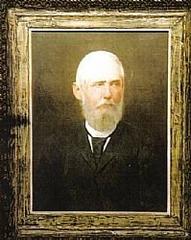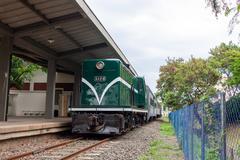E.E. Convenção De Itu Visiting Hours, Tickets, and Historical Site Guide
Date: 14/06/2025
Introduction
Situated in the heart of Itu, São Paulo, the E.E. Convenção De Itu—officially known as the Museu Republicano “Convenção de Itu”—is a landmark that encapsulates a pivotal moment in Brazil’s political history. This 19th-century mansion, the site of the historic 1873 Republican Convention, stands as a symbol of the nation’s transition from monarchy to republic and is now a vibrant museum dedicated to preserving and interpreting the legacy of Brazilian republicanism. Visitors can explore original artifacts, period furnishings, and rotating exhibitions, all while immersed in the colonial charm of Itu’s historic center. Whether you are a history enthusiast, student, or traveler, this guide provides essential information on visiting hours, ticketing, accessibility, and tips to enhance your experience in Itu.
Historical Significance of the Convenção de Itu
Political Context in 19th-Century Brazil
By the late 19th century, Brazil’s political and economic landscape was marked by growing dissatisfaction among the elite—especially influential coffee planters in São Paulo—towards the monarchy’s centralized power structure. Issues such as federalism, regional autonomy, and the slow pace of abolition fueled the desire for change (Wikipedia).
The 1873 Republican Convention
On April 18, 1873, Itu hosted the first formal republican convention in Brazil. Held in the residence of Carlos Vasconcelos de Almeida Prado, the event brought together 133 delegates—predominantly coffee planters, alongside representatives from various professions and cities. This convention was a turning point, laying the groundwork for the foundation of Brazil’s first organized republican party (InfoEscola).
Key Figures
The convention was presided over by João Tibiriçá Piratininga, with notable participants such as Prudente de Morais, who would later become Brazil’s first civilian president. The mix of conservative and liberal forces underscored the broad coalition seeking a federalist and republican future (InfoEscola).
Lasting Impact
The convention’s resolutions established an organized republican movement in São Paulo, which soon allied with similar groups in Rio de Janeiro, Minas Gerais, and within the military and clergy. These alliances proved crucial in the movement that led to the proclamation of the Brazilian Republic in 1889 (Wikipedia; Audiala).
Museu Republicano “Convenção de Itu”
History and Foundation
Located in the same mansion where the convention took place, the museum was inaugurated in 1923, precisely 50 years after the historic event. It was established under the direction of Afonso d’Escragnolle Taunay and now operates as a branch of the Museu Paulista of the University of São Paulo (Museu Republicano USP; Visite Museus).
Collections and Exhibitions
- Permanent Collection: Includes period furniture, decorative arts, portraits of republican leaders, and historical documents such as letters and newspapers. Azulejaria (tilework) panels tell the story of Itu and republican Brazil (Museu Republicano USP).
- Temporary Exhibitions: Recent highlights include “Tarsila depois de Tarsila,” showcasing Tarsila do Amaral’s modernist legacy, and a photographic collection of Japanese immigrant life in São Paulo (Campinas.com.br; Museu Republicano USP).
Educational Programs
The museum offers workshops, guided tours, and events for all ages, including activities during school holidays and commemorative dates. Collaborations with local institutions foster cultural exchange (G1 Sorocaba e Jundiaí; Museu Republicano USP).
Visiting Information
Location and Access
- Address: Rua Barão do Itaim, 67, Centro Histórico, Itu, SP (Museu Republicano USP)
- The museum sits in Itu’s walkable historic center, surrounded by colonial architecture and other notable sites.
Visiting Hours
- Tuesday to Sunday: 10:00 AM – 5:00 PM
- Closed: Mondays and certain holidays
- Always confirm hours on the official website before your visit as they may change during special events or holidays.
Tickets
- Admission: Free for all visitors. Some special exhibitions or guided group tours may require advance booking or a minor fee (G1 Sorocaba e Jundiaí).
Accessibility
- The museum has ramps and accessible restrooms, but some areas of the historic building may be difficult for those with mobility challenges. Contact the museum for specific needs (Museu Republicano USP).
Getting There
- By Car: Via Rodovia Castello Branco (SP-280); parking available in the city center.
- By Bus: Regular routes from São Paulo (Terminal Barra Funda) to Itu; taxis or rideshares from the bus terminal.
- On Foot: The historic center is compact and easy to explore.
Visitor Experience and Etiquette
- Photography: Allowed without flash or tripods in most areas.
- Language: Most signage and tours are in Portuguese. Consider booking a bilingual guide or using a translation app.
- Group Visits: Schools and large groups should schedule in advance.
- Nearby Amenities: Cafés, restaurants, and artisanal shops are within walking distance.
Exploring Itu’s Historic Center
Notable Attractions
- Praça da Matriz: Home to the baroque Igreja Matriz de Nossa Senhora da Candelária.
- Museu da Energia de Itu: Features interactive exhibits in a restored 1847 mansion.
- Praça dos Exageros: Displays oversized everyday objects, reflecting Itu’s playful “City of Exaggerations” nickname.
- Fábrica São Luiz: The state’s first steam-powered textile factory, now a cultural space.
- Bosque Alceu Geribello: Urban green space and environmental education center (Itu official tourism; Wikivoyage Itu).
Festivals and Local Culture
- Estouro do Judas: Traditional Easter celebration.
- Corpus Christi Procession: Decorated streets and religious festivities.
- Festa Italiana and Festa da Comunidade Nipo-Brasileira: Showcasing the city’s diverse heritage.
Practical Travel Information
- Travel Documentation: Valid passport; eVisas required for certain nationalities as of 2025 (brazilevisas.com).
- Connectivity: Free Wi-Fi at the museum and many cafés; local SIM cards recommended for international visitors.
- Health & Safety: Itu’s historic center is generally safe; follow standard travel precautions and keep emergency numbers handy.
- Weather: Best visited during the dry season (April–September); November features events commemorating the proclamation of the republic.
- Accommodation: Options include hotels, pousadas, and rural lodges.
Frequently Asked Questions (FAQ)
Q: What are the museum’s visiting hours?
A: Tuesday to Sunday, 10:00 AM to 5:00 PM. Closed Mondays and some holidays.
Q: Is admission free?
A: Yes, general entry is free.
Q: Are guided tours available?
A: Yes, usually in Portuguese; English tours can be arranged with prior notice.
Q: Is the museum accessible for visitors with disabilities?
A: The museum has ramps and accessible restrooms, but some areas may be challenging; contact the museum for details.
Q: Can I take photographs inside?
A: Yes, but flash and tripods may be restricted.
Q: How do I get to Itu from São Paulo?
A: By car via Rodovia Castello Branco (SP-280) or by bus from Terminal Barra Funda.
Conclusion
The Museu Republicano “Convenção de Itu” is a cornerstone of Brazil’s historical and cultural landscape, offering an immersive journey into the origins of the Brazilian Republic. With free admission, educational programming, and a prime location in Itu’s charming historic center, it is an essential destination for anyone interested in the nation’s political heritage. Plan your visit to coincide with special events or commemorations, take advantage of guided tours, and explore the city’s rich array of attractions for a fulfilling travel experience.
Call to Action
For the latest information on visiting hours, exhibitions, and events, visit the official museum website. Download the Audiala app for audio guides and enhanced visitor experiences. Follow our social channels and browse related articles to discover more about Brazil’s historic sites and cultural destinations.


